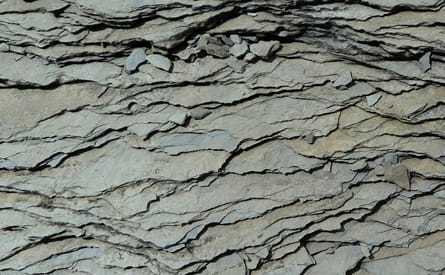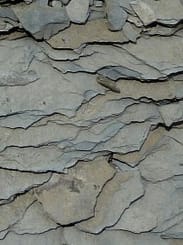
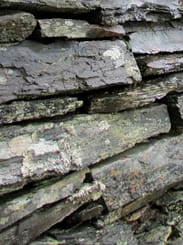
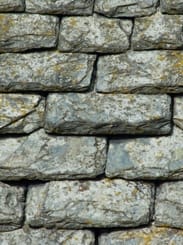
Slate (North Wales Slate)
Proving date: 1996
Proving completed by: Misha Norland, Andy Brachi, Jenny Hill & The School of Homeopathy
Common name : Slate
Download: Full proving Slate (North Wales Slate)
Download: Proving rubrics
About North Wales Slate
Protection, harmony, conflict and punishment.
For those who have been forced to act against their survival interests, perhaps because of being enslaved or living in conflict situations; they feel they have become victims, wrong has been done, they feel mocked, laughed at, yet they remain committed to keeping a balanced view. They feel divided. In response to these feelings (that they try to keep under wraps) they may want to cut, mutilate or slit with a sharp knife, those who threaten them. They can feel enlarged and tall; that they live in a mansion. They can be romantic, love poetry and music, while also feeling that life is dirty and disease ridden.
A major theme is of wanting/experiencing twoness to maintain balance; of unity vs splitting apart. Skin symptoms abound, expressing the theme of twoness, of inside and outside. Lovely landscapes outside, but danger is threatening, and there is need for protection from violence and conflict. Slate walls and slate roofs protect against the elements and provide a watertight skin. As slate is hazardous to mine, injuries to miners are common. There will usually be a story of injury, suppurating wounds, poverty, parasites, dirt and squalor.
Slate
Slate is a foliated metamorphic rock that is created by the alteration of shale, or other mudstones, by low-grade regional metamorphism. The original constituents of mudstones were silt-sized sediments of sand, clay or volcanic ash, commonly identified as mud. Shale is characterised by bedding that readily splits into thin, flaky layers along flat planes of weakness (cleavages), parallel to stratification in the sedimentary rock. Slate is found all over the World but the best geological conditions for its formation were in Britain. All British slate falls under the Palaeozoic era with Scottish being the oldest and pre-Cambrian, while in North Wales, the Penrhyn and Ffestiniog deposits are in the Cambrian and Ordovician periods respectively.
Mythology
Curses: were frequently inscribed on slates, and cursing wells were not out of the ordinary in Wales. For a curse to be effective, it had to have a northern exposure. At the Anglesey ‘cursing well’, a slate with the name of the person to be cursed, would be presented. The curser would then crawl around the well against the path of the sun, uttering appropriate curses.
History
The Welsh slate industry: began during the Roman period, when it was used to roof the fort at Segontium, now called Caernarfon. The industry grew slowly until the early 18th century when slate-mining activity was mostly for local markets. In 1782, Cae Braich y Cafn Quarry in Ogweb Valley, opened. It later became Penrhyn Quarry in 1792 – owned by Lord Penrhyn – and employed 500 men. Nationally, Welsh output was far ahead of other areas and by 1882, 92% of Britain's production was from Wales. Half of the production came from the combined output of Penrhyn and Dinorwig quarries, the 2 largest slate quarries in the World. Oakeley mine was the largest slate mine in the World. The industry expanded rapidly until the late 19th century during which time, the most important areas producing slate were in northwest Wales, where slate was mined rather than quarried.
Slate extraction: Industrial extraction of slate is achieved by using natural weakness in the cleavages. In the course of the late 1700s, black powder was introduced into the extraction process. Its slow-burning quality was favoured as it was less likely to shatter the stone and would instead, be dislodged along the line of least resistance. Breakdown of such massive pieces of slate has gradually become mechanised over the years, although most of the final splitting into tiles is still done by hand. Slate splitting is an art and it took many years to acquire the necessary skills. Those who did not manage to become skilled in the craft, continued to work as labourers or 'rubblers'. Rubblers helped to keep the galleries free from waste. The men had to pay for their ropes and chains, for tools and for services, such as sharpening and repairing. If conditions had not been good, the men could end up owing the management money. This system was finally abolished after WW2.
Quarry closures: In 1917, slate quarrying was declared a non-essential industry and a number of quarries were closed for the remainder of WW1. The outbreak of the WW2 led to a severe drop in the trade and the number of men employed in the slate industry dropped substantially. The demand for slate fell as imports from, France, Italy and Portugal increased, and the decline of slate production dropped in Wales. In 1955, Diffwys Quarry closed then further quarries in Wales followed suit. By 1972, the number of men employed at the North Wales quarries had fallen to under a 1,000 with little alternative employment in the slate-producing areas. This resulted in high unemployment and a decrease in population as young people moved away to find work. During the 1980s, came an increase in demand for slate, with production coming from Blaenau Ffestiniog area. To date, Penrhyn Quarry is still producing slate and is owned and operated by Welsh Slate Ltd. Its opponent, Greaves Welsh Slate Company, produces roof slates and other slate products from Llechwedd Quarry.
Health: Work in the quarries was dangerous and accidents were frequent. Fractures, contusions and ruptures of varying causes and degrees of severity were regular occurrences because slate is slippery when wet. The combination of wet slate and the leather soles of the men's footwear was frequently lethal. Apart from the explosive 'winning' of the slate, cuts were common and septicaemia too, often proving fatal. The state of health of both the quarrymen and their families was poor. Tuberculosis was common and the men often suffered from silicosis. It was not until the late 1800s that a link between the inhalation of slate dust and silicosis was suspected. Quarry owners went to considerable lengths to take care of their finite work force, providing healthcare facilities from the 1840s onwards. Dinorwig Quarry had its own fully-equipped hospital.
Societies for workers: Despite, or perhaps as a result of, the difficult conditions, the men were an enterprising group with a strong inclination towards self-help. Friendly societies and benefit clubs were set up to encourage saving and to protect their families against times of sickness. The University of Wales at Bangor owes its existence to the quarrymen of the Ogwen Valley. In 1874, the North Wales Quarrymen's Union was established, which lasted until 1922. Bitter clashes occurred between management and the Union. The longest and most bitter dispute was the 'Penrhyn lockout' (1900–03) that became a landmark in British Labour history. It was from this background that radical politicians began to emerge, such as David Lloyd George.
Uses: The widest and most well-known use of slate is for roofing, although by 1990 it accounted for only 5% of roofing material in Britain. Until the end of the 1700s, slate tiles could be any size or shape then, in 1750, General Warburton of Penrhyn Quarry introduced the 'female nobility' system of standardisation. In his scheme, different sizes of tile were named after female aristocratic titles e.g. 'queen', ‘princess’, 'countess', 'duchess,' 'lady', and 'empress'. When the slate's cleavage is not especially pronounced, thick slabs can be sourced for gravestones, snooker tables, mortuary slabs, and to keep food cool in kitchens. Pulverising the slate gives rise to a dust (fullerite) that is used to strengthen felt roofing and submarine cables, as an ingredient in reconstituted roofing tiles, as well as a base by the cosmetics industry. Locally to North Wales, slate chips are used as a substructure for paths and lawns. Other uses include the treatment of a disease in sheep called New Forest's disease, in which the eye is affected, resulting in blindness. It is also documented as a remedy for an ‘inward bruise’ sustained by someone after a riding accident.
The proving
The mine from which the slate was taken for the proving remains a working mine, surrounded by woodland, which is accessible to visitors. The sample of slate was from the Ordovician period. 2 provings were carried out independently of each other, using the same source of Welsh slate. The first was performed by a group of about 160 doctors in Czech Republic during a Summer school in July 1996. The remedy was taken by about half of the participants on the first day, with proving data being gathered in the auditorium over the remaining days of the Summer school. The second was undertaken in North Wales in August of the same year when a small group of supervised provers were involved.
Slate is a metamorphic rock formed from mudstone that has undergone transformation in the presence of volcanic heat and pressure beneath the Earth’s surface. It is composed of parallel foliated plates, which gives it the ability to break evenly along its cleavage. Proving themes that relate to this aspect of slate include unity and wholeness; the skin; balance and harmony; things in twos and splitting apart, dividing; empathy and protection from danger. There was unity versus splitting apart and dividing, with provers either wanting or experiencing twoness to maintain balance and harmony. One prover wrote, 'All of a sudden a voice said, “If you take 2 words away it’s out of balance and you have to put 2 back". This seems to be the theme of the whole proving for me – it’s all to do with balance'. Relating to balance, another prover noted, 'Everything felt a bit upside down – out of balance – i.e. turned around. It's as if the balance is wrong, all to do with balance'.
Twoness also featured as appreciating picturesque landscapes outside, along with a sense of danger and threat: 'About 2 little creatures who were holding each other while walking through a landscape full of flowers', and, 'I went to my room, I felt sad, that I don't belong anywhere, not even to the nature outside'. There were dreams of open landscapes and skiing that echoed the vibrant walks and pathways around the quarries, and of those that have long since closed, with nature slowly reclaiming what was left of this once great industry. In contrast to panaramas were themes of enclosed places, small rooms, darkness, and being underground.
Slate walls and roofs, that are cleaved from larger blocks, protect against the elements and provide a watertight skin. This aspect of slate was reflected in the proving in which skin symptoms were common, being symbolic of slate tiles on roofs that keep us dry. Roofs also express the theme of twoness – as inside and outside – which was represented in a dream, '... about inheriting a house that had belonged to an old man. Inside the house was very dirty and dilapidated. There were 20–30 milk bottles (empty) standing around with other detritus upon the cluttered tables and what seemed like work benches. The place was very dark and the window small. It was not a very nice place but somehow I felt at home there – or at least comfortable being there.' The dream also carries expressions of dirt and waste, with squalor on the inside of the house. Slate dust featured in the proving as haze, and hints of this essence were projected into imagery in dreams as colour, patterns, cloth and dresses.
Themes of the workplace presented strongly in the proving. The poverty of quarrymen was echoed, with one prover recording a dream as, 'A poor woman in old worn-out black trousers. I wanted to give her my old trousers but I cannot find her.' Other dreams reflected the dangers of work in the quarries, with representations of injury, hospitalisation, hospitals, and medical rooms. A prover referred to health and safety in their diary, saying, 'Regulation will result in safety'. A need for protection from danger (especially children), also surfaced in the proving, and images of empathy abounded: 'I was sitting in the corridor on the floor and protecting a poorly-dressed infant with my coat against a blizzard. The child huddled to me and said that it was nice and warm there with me.' The active fighting spirit of the quarrymen was chorused in the provers with harmony turning to conflict and knives. The proving demonstrated that Slate could be useful for those who have been forced to act against their will – perhaps as a result of being enslaved in conflict situations, with regulations and punishment – yet the individual is committed to maintaining a balanced and open view of the vista.
Download: Full proving Slate (North Wales Slate)
Download: Proving rubrics
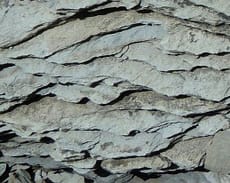
Twoness - Unity - Balance - Protection from danger - Enclosed places - Punishment - Colour - Haze - Conflict - Knives - Waste - Injury
Proving Themes
Primary: quartz,muscovite/illite
Secondary: biotite, chlorite
hematite, pyrite
Specific Gravity: 2.7 - 2.8
Composition
The term slate was also used for various objects made from slate rock from a single roofing tile to a writing slate. This was traditionally a smooth piece of rock, framed in wood and used with chalk to record charges in pubs and inns. The term clean slate and blank slate derives from this use. Slate is extremely durable for the use in buildings and can last for several hundred years.

.jpg)
